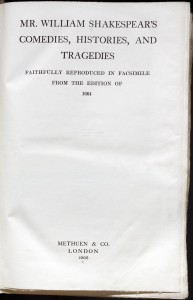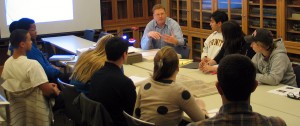 In a humble little volume with the spine title “Collection of Pamphlets” (volume 14), bound with six other unrelated titles, is The Journal of Major George Washington sent by the Hon. Robert Dinwiddie, Esq; His Majesty’s Lieutenant-Governor, and Commander in Chief of Virginia, to the Commandant of the French Forces on Ohio . . . with A New Map of the Country as far as the Mississippi.
In a humble little volume with the spine title “Collection of Pamphlets” (volume 14), bound with six other unrelated titles, is The Journal of Major George Washington sent by the Hon. Robert Dinwiddie, Esq; His Majesty’s Lieutenant-Governor, and Commander in Chief of Virginia, to the Commandant of the French Forces on Ohio . . . with A New Map of the Country as far as the Mississippi.
Intitially printed in Williamsburg in 1754 (of which there are only seven (7) copies reported in institutional libraries), ours is a copy of the London reprint of the same year, held by thirty (30) other libraries. Washington’s fame at home and abroad begins with this pamphlet.
“In the early part of the 1750s French and English forces were expanding into the Ohio Valley, both forming alliances with Indian tribes and setting up trading encampments. In 1753 the French took possession of a tract of land within the chartered limits of Virginia. They then proceeded to erect a chain of military posts from Canada to the Ohio River. All the while, French soldiers and traders made their way up from the south and down from the north, taking possession of the Ohio country. The French encroachments on the English settlements forced Virginia Governor Robert Dinwiddie to send a commission to warn the French to halt their advances. However, the commission stopped 150 miles short of the French posts and turned back after witnessing the slaughter and defeat of the Indians by the French.
 An officer in the Virginia forces — Major George Washington — was recommended to Dinwiddie as an up-and-coming light, someone who might accomplish the mission. Although only 21 years old, Washington was appointed by Dinwiddie to go into the Ohio Valley and deliver a letter to the commander of the French forces, warning him against their actions in violating British rule over those lands. In addition, Washington was to observe French activity and enforcements, and make friends with the Indian tribes.
An officer in the Virginia forces — Major George Washington — was recommended to Dinwiddie as an up-and-coming light, someone who might accomplish the mission. Although only 21 years old, Washington was appointed by Dinwiddie to go into the Ohio Valley and deliver a letter to the commander of the French forces, warning him against their actions in violating British rule over those lands. In addition, Washington was to observe French activity and enforcements, and make friends with the Indian tribes.
On October 31, 1753 Major Washington set out from Williamsburg with a small band of men experienced in the ways of the wilderness. The group consisted of Jacob Van Braam, a Dutch soldier of fortune and French interpreter; Christopher Gist, a Virginia frontiersman of great renown; two servitors; two Indian traders and accompanying horses. During Washington’s 78 days in the wilderness he met with chiefs of the Indian nations and delivered Gov. Dinwiddie’s letter to the French Commandant, LeGardour de St. Pierre. In a private meeting with Major Washington the French Commandant refused to back down.
On their return to Williamsburg Washington’s entourage encountered bitter cold, deep snow, ice and freezing rain. At one point Washington writes in his Journal “…our horses were now so weak and feeble, and the baggage heavy….therefore myself and others gave up our horses for packs…” Washington disguised himself in Indian dress while he and Gist decided to return alone on foot. While traveling through the woods they ran into an ambush of French Indians. One of the Indians…”not 15 steps away”… fired at the pair but missed. While crossing a turbulent river on a homemade raft, Washington was thrown off into 10 feet of water. The weather was so severe, he writes in his Journal, “that Mr. Gist had all his fingers, and some of his toes frozen.”
Washington returned to Williamsburg on January 16, 1754. He spent the entire next day writing his account from the entries he had made during the course of the trip. The following day — January 18 — his Journal was presented to the Virginia Assembly which immediately raised a regiment of 300 men to defend their frontiers and maintain England’s rights over the disputed territory.”
Quoted from http://www.earlyamerica.com/earlyamerica/milestones/journal/

















